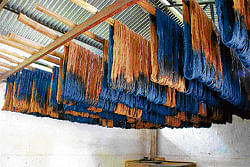Mahatma Gandhi used the Charaka, the humble spinning wheel, as a weapon to take on

the mighty British. A women’s cooperative society in Bhimanakone village of Shimoga district named after this fascinating tool by way of which the Father of the Nation created a flutter in the market system promoted by the British, has proved that development can also be inclusive and eco-friendly.
Charaka has made such a strong impact that landlords are finding it difficult to hire workers though they are ready to offer lucrative salaries. Most labourers are now working at Charaka.
Charaka, which is engaged in producing naturally dyed cotton handloom garments, markets its products under the brand name ‘Desi.’ It is generally assumed that heavy subsidies are pumped into the maintenance of khadi units. Charaka, the production unit and the Desi chain of retail stores have registered a combined annual turnover of Rs 60 million and the grant they avail from the government as part of the rural development initiative is less than five per cent of the turnover. The success story of Charaka can qualify to be a case study for business schools also.
Charaka has a workforce of over 350 now. The workers are their own pay masters here and earn handsomely. Annual bonus, subsidised food, health insurance and loans are the other benefits which workers enjoy here.
Kavi-Kavya’s activities
Residents of Bhimanakone have shown that Grama Swaraj, women’s empowerment, sustainable and eco-friendly development are not mere concepts to preach but can also be practised. Literature lovers of the village established Kavi-Kavya, a forum to promote cultural activities in 1994. A training programme was organised for anganawadi workers in the villages of the district by Kavi-Kavya on the use of locally available resources.
It was an opportunity for members of Kavi-Kavya to understand the rural life of Malnad region. During interaction with villagers, they realised that people in Malnad were heavily dependent on agriculture. As population increased, immense pressure was exerted on the eco-system. Forests were cleared and converted into cultivable land in many places.
Weaving centre
Kavi-Kavya members realised that the pristine forest of Malnad region can be saved by enabling them to participate in ecologically-friendly productive activities. With this objective, Kavi-Kavya members set up a weaving centre on an experimental basis at Bhimanakone.
Kavi-Kavya Trust handed over the entire infrastructure to 30 women workers, who eventually organised themselves to form the Charaka Society.
The activity of marketing garments produced by Charaka was unorganised initially. Kavi-Kavya members set up their stall at literary meets held in various parts of the state where khadi products were exhibited and sold. The members were humble and honest enough to admit that the product was not 100 per cent perfect. But people bought their products to identify themselves with the transformation that was taking place in Bhimanakone.
Kavi-Kavya members later formed a trust called DESI-Developing Ecologically Sustainable Industry (which also means indigenous in Kannada) to ensure an organised and streamlined market for the products of Charaka which by the time were becoming popular. The products were marketed under the brand name ‘Desi.’
Desi now has nine retail outlets at various urban centres of the state. What makes the experiment at Bhimanakone interesting is that both Charaka and DESI don’t have puritan view towards Gandhian ideology. They have realised that Gandhian ideologies need to be experimented with some modifications to achieve success in the present day. To make khadi garments acceptable to the new generation, they sought advise from professional designers.
The organisation even opted for a professional marketing arrangement. Eminent designers, chartered accountants, theatre activists, writers, film makers and marketing professionals are part of team DESI now.
The production practices at Charaka are consistent with Gandhian beliefs. Most of the production is manual here and machines are used wherever necessary. Mahatma Gandhi who was critical of machine-based production however was fascinated with the sewing machine as he believed that “as long as the machine does not curtail human labour and human dignity, it is good.”
Theatre activist Prasanna, who was instrumental in the establishment of Charaka, said the organisation functions in a democratic fashion. “The president of the organisation too has to weave clothes. Even computer professionals spend some time on the hand looms. Caste system restricted occupational mobility and at Charaka we want to overcome it,” he observed.
Charaka has plans to promote production of natural dye in the region. Malnad is rich with raw materials like gur, areca and soapnut used to prepare natural dye. Farmers can supplement income from land through natural dye preparation units. One such unit has come up in the land of Umapathi Gowdru at Atawadi village near Sagar with the assistance of Nabard.
Prasanna said that clothes prepared from natural dye enjoy good value in the market. Charaka also has plans to set up a training centre for rural artisans.
In fact, many educated youths who want a change from the monotony of city life are eager to associate themselves with Charaka now.
Take the instance of Chaitra, who was working for a reputed BPO company. She has now joined Charaka. She stays in Bhimanakone and has been assigned the responsibility of documenting the activities here. Fashion designer Sandesh gave up a lucrative career in the Gulf to work with Charaka. Charaka and DESI have not only arrested the exodus of rural people towards urban centres but have also reversed the trend.